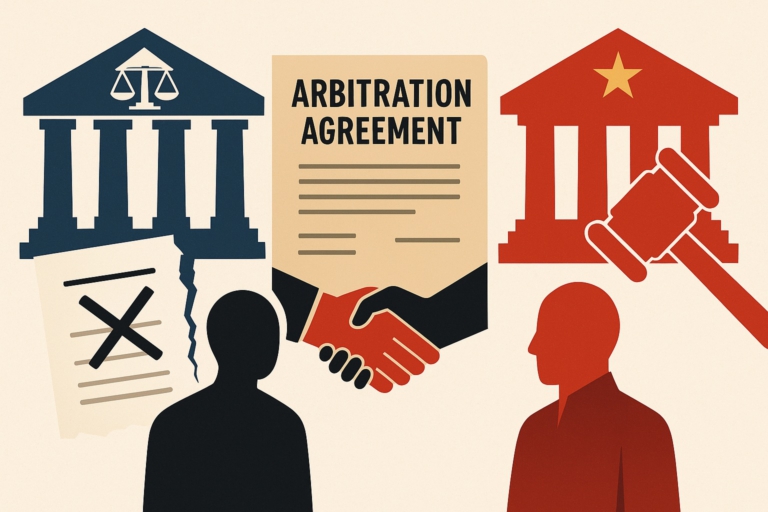
Can cases be heard asynchronously? The answer is “Yes”. Don’t miss the rules of asynchronous trial and electronic evidence, the highlights of China’s Supreme Court’s newly issued “Online Litigation Rules for People’s Courts” (2021).
The “Online Litigation Rules for People’s Courts” (hereinafter referred to as “the Rules”, 人民法院在线诉讼规则) promulgated by China’s Supreme People’s Court (SPC) is the first online litigation rules systematically formulated in China.
In the previous post, we have introduced its scope of application and adjudication rules. In this post, we will continue to introduce the rules of asynchronous trial and electronic evidence.
1. Can cases be heard asynchronously?
The answer is “Yes”.
In traditional offline litigation, the parties communicate instantaneously in the same courtroom. Such synchronous trial is common in litigation, in which all parties participate in the litigation in the same place simultaneously.
For online litigation, where the parties are definitely in different locations, it is technically possible to allow the parties to participate in the litigation asynchronously. The information is then collected and exchanged via the online litigation system.
The Rules explicitly provides that, with the consent of all parties, a court may designate the parties to log onto the litigation platform within a certain period of time to carry out litigation activities in an asynchronous manner. (Article 20)
This is the first time that China confirms the rule of asynchronous trial.
At the same time, however, the Rules also narrows the application scope of asynchronous trials as follows:
i. The court shall focus on synchronous trial while asynchronous trial shall be carried out under restricted circumstances, i.e., the asynchronous trial is generally applicable to the circumstances under which it is inconvenient for the parties concerned to participate in the litigation activities in person or the court is short of judicial resources.
ii. Since asynchronous trials involve the procedural rights of the parties, the prerequisite for applying such a procedure is the mutual consent of the parties.
iii. The major facts and evidence to which the procedure is mainly applicable are indisputable.
The procedure is mainly limited to small claims or civil and administrative cases to which the summary procedure is applicable.
v. In applying this procedure, the court shall record the proceedings by videotape and not in writing.
2. How are electronic materials used?
(1) Types of electronic materials
As papers and physical objects are essential elements of offline litigation, electronic materials are the foundation for online litigation. The Rules lists the types of electronic materials. (Article 11)
In terms of content, electronic materials are divided into litigation instruments and evidence materials.
In terms of ways of manifestation, electronic materials fall into three types:
The first type is the online input of materials, i.e., the electronic texts that the litigants directly input on the electronic litigation platform, such as the complaint filed online.
The second type is electronic materials, i.e. materials which are digitally processed by means of scanning, reproducing, and transcribing the hard copies, such as the scanned complaint.
The third type is raw electronic data, i.e., materials initially presented in electronic form, such as electronic contracts. If the information platform storing the above electronic data has been connected to the court litigation platform, the electronic data can be directly imported into the litigation platform.
(2) Effect of electronic materials
Electronic materials shall be deemed as originals, except under special circumstances. (Articles 12 - 15)
After the parties submit the electronic materials, there is no need to submit the corresponding original hard copies, unless the authenticity of the evidence is doubted, the format is not standardized, the content is unclear, or the evidence does not meet the filing requirements of the court.
Since electronic materials are easily tampered with, the court needs to review the consistency of the electronic material and the originals, and needs to resort to certain external resources, such as recognition of the other party, notarization, confirmation of previous litigation activities, online or offline comparison, etc.
3. How to use the electronic data stored in blockchain?
At present, China's procedural laws and relevant judicial interpretations have made relatively systematic and comprehensive provisions on the examination and identification of electronic evidence, so the Rules does not repeatedly specify the general rules for electronic evidence examination.
However, the Rules details how to deal with the evidence stored in blockchain (referred to as “blockchain evidence”). As the parties and third-party service agencies actively engage in blockchain evidence nowadays, the SPC believes it is necessary to make regulations.
(1) The concept of blockchain evidence
There is no official expression of “blockchain evidence” in China's procedural laws, so such expression is not adopted in the Rules. Instead, it is described as “electronic data stored via blockchain technology” in technical terms. Such evidence is a kind of electronic evidence in nature.
(2) Presumption of the authenticity of blockchain evidence
Blockchain technology can, to a significant degree, guarantee that data is difficult to be tampered with after being stored in the blockchain. Therefore, the Rules establishes the principle for presuming the authenticity of blockchain evidence.
In other words, if the electronic data submitted by the parties as evidence is stored via blockchain technology and is consistent with the technical verification, the court may deem that the electronic data has not been tampered with after being stored in the blockchain, unless there is sufficient evidence to the contrary to invalidate it. (Article16)
(3) One of the exceptions to the presumption of authenticity: after the electronic data being stored in the blockchain
Although blockchain technology has the advantages and characteristics of tamper-proofing, such kind of technical support is not perfect. Factors such as the underlying structure, consensus mechanism, number and distribution of nodes of the blockchain technology, the legitimacy of the evidence depositor, the software and hardware systems on which the evidence storage relies, and even the technical specifications of evidence storage may affect the authenticity of the data after the data is stored in the blockchain.
As a result, the parties can challenge the blockchain evidence and state their reasons. (Article 17)
(4) The second exception to the presumption of authenticity: before the electronic data being stored in the blockchain
Blockchain technology does not guarantee that the electronic data is authentic before being stored in the blockchain, i.e., the source of the data may not be authentic. Therefore, if the party raises an objection, the court shall carry out an examination. (Article 18)
4. Our comments
As we have noted in the previous post, the establishment of three Internet Courts is just a start in China's efforts to popularize online litigation technology across the country.
If there is one thing we can learn from the Rules, it is that the SPC wishes not only to promote online litigation technology across the country, but also to develop more tailored litigation rules for such technology.
Contributors: Guodong Du 杜国栋 , Meng Yu 余萌









